| |
|
St
Nicholas, Dersingham
 |
|
It
was about four o'clock in the afternoon on one of
those drowsy days in the summer of 2006. We
arrived at Dersingham only to find them locking
it up for the day, taking the signboard in and
bolting the doors. The man apologised, but he
couldn't hang around as he had an appointment
elsewhere. Oh well, we thought, we'll come back. Ten years
passed. And now I was cycling around the lanes to
the north-east of King's Lynn, ticking off the
last few Norfolk churches I still had to visit,
and St Nicholas at Dersingham was one of them. I
always think that there's a kind of listlessness
to this part of Norfolk, almost a malaise. I
can't really explain it. It seems to rise from
the marshlands and settle over Kings Lynn and the
woods of the Sandringham estate. I would escape
it very quickly as I cycled up the steep hill
towards Shernborne, but here at Dersingham the
clouds were leaden and there was a heaviness in
the air. It might also be the Sandringham effect,
something that holds these towns and villages in
the past, as if it might still be the 20th
Century here. This, I hasten to add, is no bad
thing. Dersingham is the largest of the villages
that straggle along the Wash between Lynn and
Hunstanton, and I remember travelling through
them as a child on the way from Cambridge to the
beaches of Heacham and Hunstanton in the 1960s.
Dersingham reminded me of my childhood.
|
St
Nicholas is a big church, sitting just to the north of
the Sandringham estate. There's pleasing harmony about
the juxtaposition between the early 14th Century chancel
and the late medieval nave and aisles, all overlooked by
the Perpendicular tower. Everything is in happy
proportion. There was a good restoration of the church in
the 1870s which maintained this unity but also celebrated
its individual parts. In fact, you don't really see quite
how big the church is until you step inside - as Pevsner
notes, the nave is remarkably wide. The glass in
the south aisle is not intrusive in this great space, and
it is good of its kind, apart from one oddity. It is by
Christopher Powell, and there are two windows, one from
the 1920s, the other from the 1930s. The earlier window
is in memory of Edwin and Agnes Woodward, and depicts
Christ flanked by St Agnes and St Luke, suggesting that
Edwin Woodward was a doctor. The two outer figures are
beautiful, but at some time the central figure has been
damaged and repaired. Christ's replacement head is very
badly done, poorly drawn and out of proportion. It seemed
a shame.
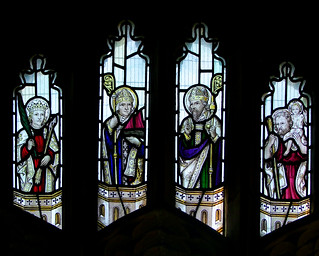 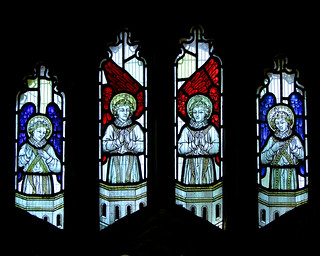
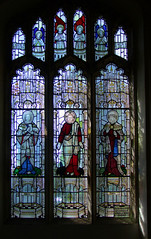 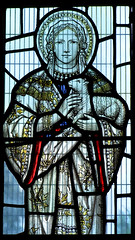 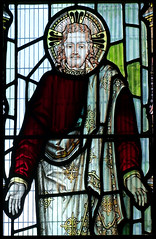 
There is
more glass in the chancel, mostly by Kempe & Co. The
low side window is curiously and beautifully carved as
four quatrefoils. On the north side of the chancel there
is another curiosity, the early 17th Century incised tomb
chest featuring the figures of John and Joanna Pell. As
Mortlock observes, it is exactly as if they had been cast
in brass. Their sons and daughters kneel piously around
the sides. It seems likely that the tomb was moved by the
Victorians, as originally all four sides were probably
intended to be seen.
There are
more Pell memorials on the south side of the chancel, and
beneath them is probably the most famous thing about
Dersingham church. This is the ancient parish chest,
dating from the middle of the 14th Century in the years
of the Black Death. It is as big as a tomb, and carved
elaborately with the symbols of the four Evangelists. On
top, there is part of the inscription Jesus Nazarenus
Crucifixus Judaeorum ('Jesus of Nazareth crucified
by the Jews'). A remarkable thing to see.
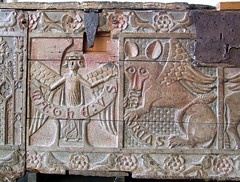 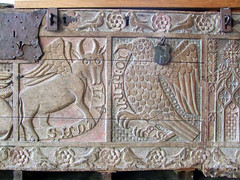
The
Victorian restoration of the rood screen revealed six
figures on the north side dado. St Apollonia holds her
tooth in a pair of pincers. She was that most essential
of figures in the medieval economy of grace, being
invoked in prayers against toothache. In East Anglia she
was often paired with St Lawrence, invoked in prayers
against fires, and he may well have matched her on the
south side. Beside her, St Denys holds his whole head, as
if holding a mere tooth were nothing to show off about.
The next figure is probably St Withburga, and then a very
heavily circumscribed chap who is probably St Giles given
the hind at his feet. The other two figures are St
Juliana leading a little devil on a chain, and a bishop,
who may be St Cyprian.
| The
rood group on top of the screen was given in 1917
by Frederick Rolfe in memory of Dersingham
men killed in the war - Mortlock notes that
they were carved by a craftsman from the
woodcarving school on the nearby Sandringham
estate. A more substantial memorial to the
Dersingham lads is the chapel in the north aisle,
the boards featuring a shocking number of names
for such a small place. Above the
north doorway is a set of royal arms curiously
split into three separate parts, the supporters
not connected to the shield. Mortlock says that
it originally came from a shopfront where the
owners had held the royal warrant. Can that be
true? I do like to think so, and such a thing
seems so much more likely here in the hinterland
of Sandringham.
And
so, that was that. I'd finally come back to
Dersingham. I stood in the churchyard and thought
about the past for a moment, both the recent and
the distant, and then I headed north and east,
climbing into the rolling barley fields and
hidden villages of the most secretive part of
Norfolk.
|
|
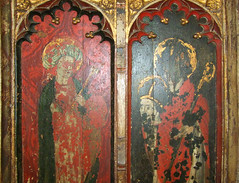 |
|
|
|
